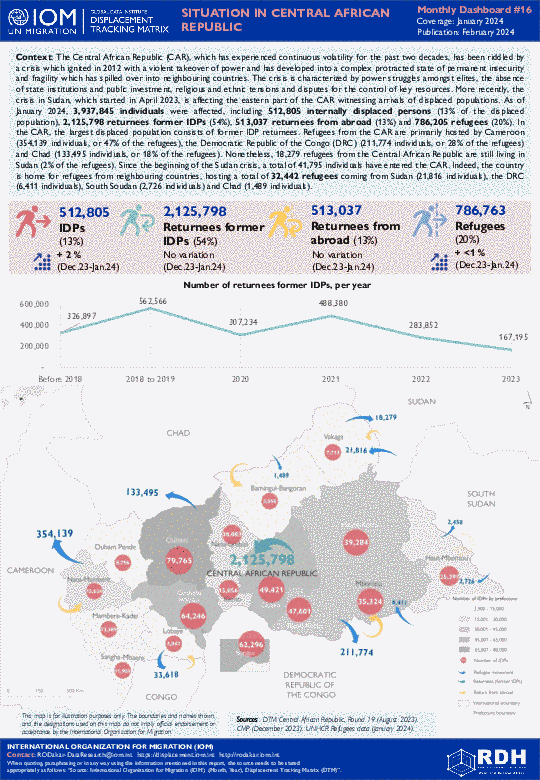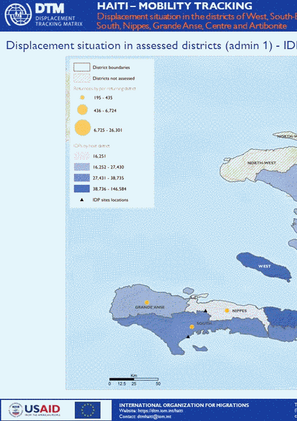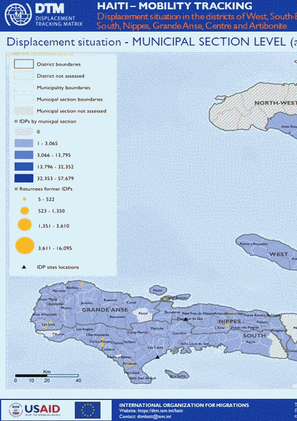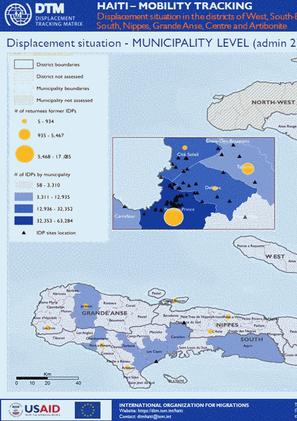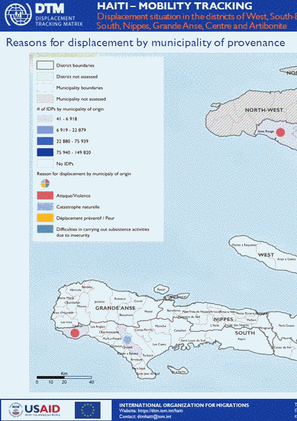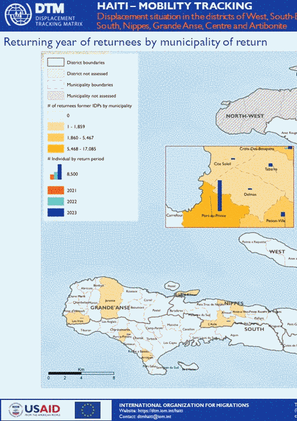-
Countries
-
Data and Analysis
-
Special Focus
-
Crisis Responses
Baseline Assessment
The Central African Republic (CAR), which has experienced continuous volatility for the past two decades, has been riddled by a crisis which ignited in 2012 with a violent takeover of power and has developed into a complex protracted state of permanent insecurity and fragility which has spilled over into neighbouring countries. The crisis is characterized by power struggles amongst elites, the absence of state institutions and public investment, religious and ethnic tensions and disputes for the control of key resources. More recently, the crisis in Sudan, which started in April 2023, is affecting the eastern part of the CAR witnessing arrivals of displaced populations.
As of January 2024, 3,937,845 individuals were affected, including 512,805 internally displaced persons (13% of the displaced population), 2,125,798 returnees former IDPs (54%), 513,037 returnees from abroad (13%) and 786,205 refugees (20%). In the CAR, the largest displaced population consists of former IDP returnees. Refugees from the CAR are primarily hosted by Cameroon (354,139 individuals, or 47% of the refugees), the Democratic Republic of the Congo (DRC) (211,774 individuals, or 28% of the refugees) and Chad (133,495 individuals, or 18% of the refugees). Nonetheless, 18,279 refugees from the Central African Republic are still living in Sudan (2% of the refugees). Since the beginning of the Sudan crisis, a total of 41,795 individuals have entered the CAR. Indeed, the country is home for refugees from neighbouring countries, hosting a total of 32,442 refugees coming from Sudan (21,816 individuals), the DRC (6,411 individuals), South Soudan (2,726 individuals) and Chad (1,489 individuals).
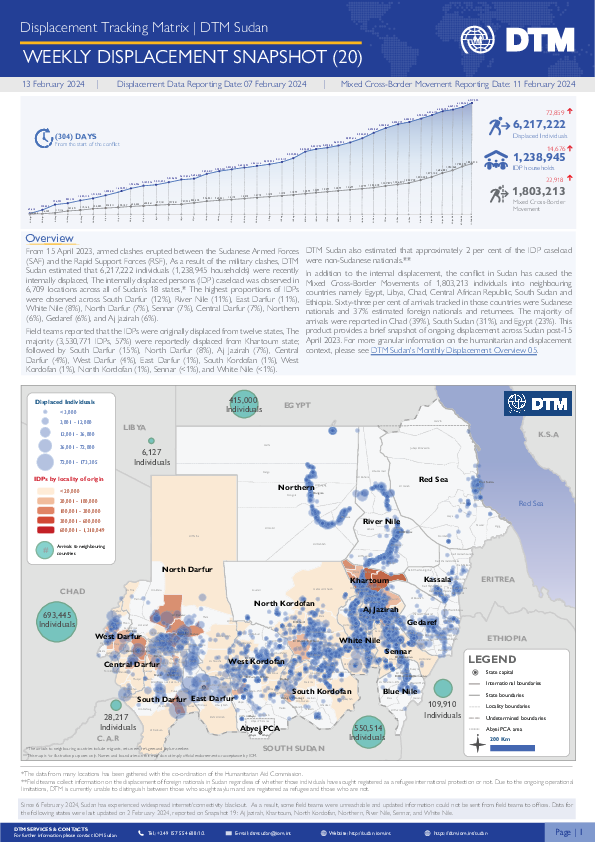
Contact
DTM Sudan; dtmsudan@iom.int
Language
English
Location
Sudan
Period Covered
Feb 03 2024
Feb 07 2024
Activity
- Mobility Tracking
- Baseline Assessment
Overview
From 15 April 2023, armed clashes erupted between the Sudanese Armed Forces (SAF) and the Rapid Support Forces (RSF) in multiple cities across Sudan. Clashes initially took place in cities across Northern and Khartoum states, later spreading across the Darfur and Kordofan regions.
Highlights
- DTM Sudan estimates that 6,217,222 individuals (1,238,945 households) were recently internally displaced.
- The IDP caseload was observed in 6,709 locations across all of Sudan’s 18 states.
- The highest proportions of IDPs were observed across South Darfur (12%), River Nile (11%), East Darfur (11%), White Nile (8%), North Darfur (7%), Sennar (7%), Central Darfur (7%), Northern (6%), Gedaref (6%), and Aj Jazirah (6%).
- Field teams reported that the IDPs observed were originally displaced from twelve states. The majority (3,530,771 IDPs, 57%) were reportedly displaced from Khartoum state; followed by South Darfur (15%), North Darfur (8%), Aj Jazirah (7%), Central Darfur (4%), West Darfur (4%), East Darfur (1%), South Kordofan (1%), West Kordofan (1%), North Kordofan (1%), Sennar (<1%), and White Nile (<1%).
- IOM-DTM also reported that an estimated 1,803,213 mixed cross-border movements were made into neighbouring countries.
- This product provides brief insights into those displaced in Sudan post-15 April 2023. For more granular information on the IDP caseload and the displacement context, please see IOM-DTM's Monthly Displacement Overview (05).
DISCLAIMER: Since 6 February 2024, Sudan has experienced widespread internet/connectivity blackout. As a result, some field teams were unreachable and updated information could not be sent from field teams to offices. Data for the following states were last updated on 2 February 2024, reported on Weekly Displacement Snapshot 19: Aj Jazirah, Khartoum, North Kordofan, Northern, River Nile, Sennar, and White Nile.
This map is the result of DTM evaluations conducted in 7 of Haiti's 10 departments. It presents the displacement situation (IDPs and formerly IDP returnees) at the level of districts (admin 1)
This map is the result of DTM evaluations conducted in 7 of Haiti's 10 districts. It presents the displacement situation (IDPs and formerly IDP returnees) at the level of the municipal sections (admin 3)
This map is the result of DTM evaluations conducted in 7 of Haiti's 10 districts. It presents the displacement situation (IDPs and returned formerly IDPs) at the municipal level (admin 2)
This map is the result of DTM evaluations conducted in 7 of Haiti's 10 districts. It presents the reasons for the return of returnees by their municipalities of return
This map is the result of DTM evaluations conducted in 7 of Haiti's 10 districts. It presents the reasons for the displacement of IDPs by their current host municipalities.
This map is the result of DTM evaluations conducted in 7 of Haiti's 10 districts. It presents the reasons for the displacement of IDPs by their municipalities of origin
This map is the result of DTM evaluations conducted in 7 of Haiti's 10 districts. It presents the years of return of returnees formerly IDPs, by their current municipalities
This map is the result of DTM evaluations conducted in 7 of Haiti's 10 districts. It presents the years of displacement of IDPs by their current host municipalities
Pagination
- Previous page
- Page 44
- Next page
